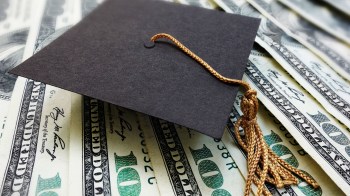Debt relief could be on the way for some students
CORRECTION: The original version of this story incorrectly stated the percentage by which monthly payments are expected to be lower under the federal government’s new Pay-As-You-Earn program, based on research by the Institute for College Access and Success. The text has been corrected.
A bit of relief arrives at the end of the week for student debtors, in the form of the a new ‘Pay-As-You-Earn’ repayment program from the federal government. It kicks in on Friday, Dec. 21, and will supplement the current income-percentage-based repayment plan on the books since 2009, called Income-Based-Repayment (IBR). Pay-As-You-Earn will offer current college students and recent graduates a lower monthly payment and shorter repayment terms than IBR.
Under Pay-As-You-Earn, borrowers will pay back 10 percent of their discretionary income for up to 20 years. Then, whatever’s left on their federal student loan is forgiven. The IBR plan takes 15 percent of income for 25 years. Pay-As-You-Earn will be available for anyone who took out a first federal student loan after September 30, 2007, and received a loan disbursement after Sept. 30, 2011. It will benefit primarily current and recent undergraduates.
Economist Mary King at Portland State University, who is teaching a senior seminar this semester titled ‘Student Debt: Economics, Policy and Advocacy’, says the old model of fixed monthly interest-and-principal payments — which can be several hundred dollars per month or higher — is untenable.
“Something has to give,” says King. Nationwide, the average graduate in the class of 2011 entered the workforce with $26,600 in federal student loan debt. King points out that many of her students, at the largest public university in Oregon, also take on other debt to pay tuition and expenses, including private bank loans, while also working part- or full-time.
“The load on young people right now is appalling, student loan debt is now larger than credit card debt, and it’s hampering people at a time when they have all kinds of other economic issues against them,” says King.
The biggest burden they face immediately, in the aftermath of the Great Recession, is high unemployment and low wages, says Lauren Asher at the Institute for College Access and Success.
“Research consistently shows that starting your career during a down economy can suppress your earnings for more than a decade,” Asher says.
Student-debt advocates say after college, instead of paying for an education recent graduates have already received, they should be saving — for a down payment on a home, for more education to advance their career and earning-power, or for retirement. This has become even harder with soaring loan burdens and bankruptcy-law changes that make discharging student debt through bankruptcy harder.
Some critics of recently introduced income-based repayment plans say they invite moral hazard — encouraging graduates to pursue careers in social services or the arts that pay very low wages, so as to avoid large repayment bills. Critics have also questioned whether the new plan will benefit lower-income students as much as those from wealthier families.
Asher says her group’s research suggests that Pay-As-You-Earn will benefit those at the bottom. She says a student leaving school in 2012 with the average national debt load ($26,600), making $25,000 in adjusted gross income, will pay 33 percent less than the monthly payment under the previous Income-Based-Repayment (IBR) plan.
Economics professor Mary King’s students, meanwhile, are developing a much more radical type of education funding model, for which they’re lining up sponsors in the upcoming state legislative session. Their plan is called “Pay-it-Forward.” Oregon students would attend college for free. Then, for the next ten years, they would pay 3 percent of their income into a state fund to cover the education of future students. The state would likely need to issue bonds to replace lost tuition and maintain funding levels for the university, until Pay-It-Forward began to deliver revenue from graduates’ income. Other states are also exploring similar models.
Students’ post-graduation education payments would not be defined as a debt, says King, with all the financial liabilities that entails — but would instead be treated as a social insurance levy, deducted from income like other taxes. King says the system would operate like Social Security — but with current earners paying for the education of students coming up through the higher-education system after them.
There’s a lot happening in the world. Through it all, Marketplace is here for you.
You rely on Marketplace to break down the world’s events and tell you how it affects you in a fact-based, approachable way. We rely on your financial support to keep making that possible.
Your donation today powers the independent journalism that you rely on. For just $5/month, you can help sustain Marketplace so we can keep reporting on the things that matter to you.


















